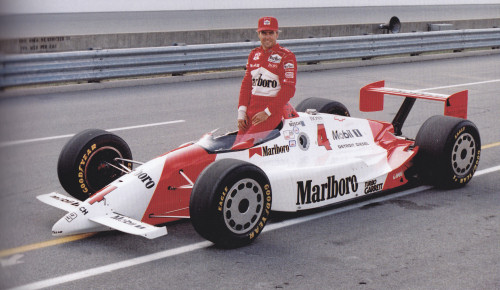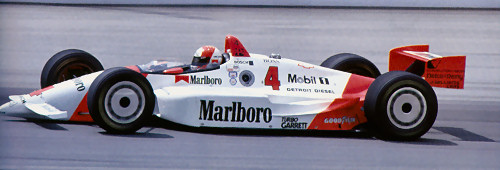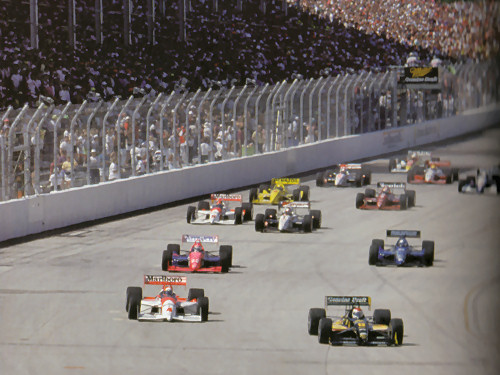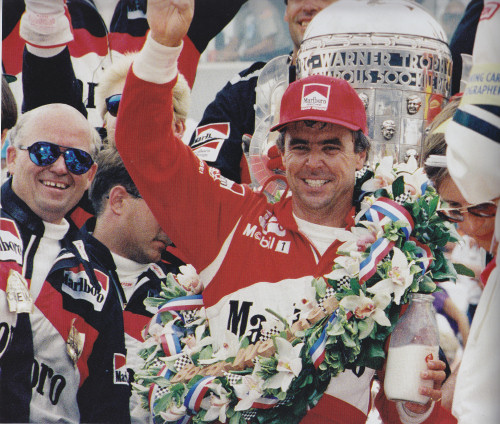The Way It Is/ The Mears way of racingby Gordon Kirby |
 He was a maestro on ovals in particular and the great new star of Indy car racing through the late seventies and early eighties. As CART's Indy Car World Series blossomed and boomed Rick Mears earned the nickname 'Rocket Rick' taking three Indy car championships in four years between 1979'-82 and winning four Indy 500s and a record six poles at the big speedway. More than that Rick was a true gentleman racer, clean and fair at all times both on and off the track.
He was a maestro on ovals in particular and the great new star of Indy car racing through the late seventies and early eighties. As CART's Indy Car World Series blossomed and boomed Rick Mears earned the nickname 'Rocket Rick' taking three Indy car championships in four years between 1979'-82 and winning four Indy 500s and a record six poles at the big speedway. More than that Rick was a true gentleman racer, clean and fair at all times both on and off the track.
A laid-back, good-looking Californian he set the standard by which all others were judged, as well as being a tremendous racer who everyone admired and respected. Mario Andretti says Mears was one of the most fair, ethical drivers he ever raced against over his long career. Andretti says Mears' behavior always was impeccable. "He was very polished," Andretti says. "He was probably one of the most correct drivers to race against. I always had the greatest respect for Rick.  © Paul Webb "I think he was probably the most misread individual because he was always very kind, very laid-back. But I don't think anybody's fire burned in his belly any brighter or any stronger than when Rick was in a race car." Rick spent almost his entire professional career from 1978-'92 with Penske Racing and through the 1980s and into the early nineties he was considered the King of the Indianapolis Motor Speedway. He won four Indy 500s in 1979, '84, '88 and '91 and was on the front row in eleven of the fifteen 500s he started before retiring at the end of 1992. Mears drove with tremendous confidence and precision, silky smooth at all times and superb at threading his way though traffic on short one-mile ovals like Phoenix and Milwaukee. Beyond his superlative record Mears showed true grit by coming back from a terrible accident at the tiny Sanair, Quebec oval in September of 1984. The accident smashed Rick's feet and it took every ounce of famed orthopaedic surgeon Dr. Terry Trammell's immense skill to save his feet and get Rick on the road to recovery. "Roger got me hooked up with Dr. Trammell and he saved my feet," Mears relates. "Had that happened a couple of years earlier I probably would have lost them. Technology helped save them and they learned a lot from my feet, too. After that they also wrote new rules to strengthen the footbox and the nose of the cars. And of course, there was the guardrail. If it had been concrete I probably would have just fractured a few bones, but it wouldn't have been anywhere near as bad." Despite intense pain and bleeding in his bandaged feet Mears was back in action at Indianapolis the following spring and scored his first post-accident victory three months later in the Pocono 500 in August, 1985. Nor did his foot injuries prevent him from winning on road courses as he showed when he won emphatically from the pole at Laguna Seca in 1989, leading all the way. Still, Rick's injuries remain with him to this day, making it difficult to walk and climb out of bed some mornings, but he never complains. Since retiring twenty years ago Rick has continued as a driver coach for Team Penske providing an invaluable resource to Penske's drivers. During the last two decades Mears has advised and coached many successful Penske drivers from a young Paul Tracy through Al Unser Jr., Gil de Ferran and Sam Hornish at the peak of their careers to today's drivers Will Power, Helio Castroneves and Ryan Briscoe.  © Indianapolis Moter Speedway At IndyCar's oval races Mears 'spots' for Helio Castroneves, joining the other spotters high atop the grandstands where they can see the entire track and help their drivers maneuver in the closely-packed quarters of contemporary Indy car racing. "I enjoy doing that," Mears remarks. "It's fun and it's another way of keeping your hand in and trying to help. Helio is the kind of driver who doesn't do a lot of conversation on the radio, which is good. I think that's the way it should be. If drivers are doing their job and doing the things they need to do they don't need a lot of spotting. If they're doing their part they should know what's going on around them at all times. "The driver drives the car," he adds. "If you know what's going on around you, you can make moves and get into places before a spotter has a chance to clear you from his vantage point. To me, a spotter is a back-up. He's a secondary in case the driver misses something. That's the way it should be looked at." Spotting has become so prevalent over the past ten years in IndyCar and NASCAR that many of today's young drivers don't believe Mears when he tells them he never had a spotter when he raced. "I never had a spotter through my whole career and when I tell the kids that they look at me and say, 'You what?!' They can't believe it. Some of them say, 'You've got to be kidding me. How did you do that?' They're convinced it's a necessity. But by all rights, if they're doing their part the way I feel it should be done, then the spotter is just a back-up. "Now, don't get me wrong," Rick adds. "Spotters are a good thing. They can give you a heads-up if something develops ahead of you and give you a direction of which way to go. It's good that we have spotters but the part I disagree with is when the drivers start relying too much on their spotter. The problem gets worse when the guy starts relying on the other guy's spotter too. That's when it develops into a real problem." We see and hear regular complaints these days about blocking. Mears says the technique always was entirely foreign to him. In fact, he believes it's antithetical to the true spirit of racing and competition. "If I had to block somebody to win, I didn't do my job," he remarks. "In my mind I didn't win the race because my job is to outrun the other guy. To me, that's winning. The number one thing is it takes talent to out-run the other guy. That's the whole reason we're there--to race and win fairly by showing our talent. Not by blocking. That's my personal opinion.  © Steve Swope "At the end of the day it was about me feeling good about myself earning the win. That's why my fourth win at Indy was the best because we got to have the shoot-out (with Michael Andretti). It was a straight-up contest. "To me, as far as blocking and being ethical on the track, it's all part of a big package. Besides that there's the safety part of it. I knew that if I tried to block somebody and if something happened then it would take me out as well as the other guy. And of course, it also meant I couldn't win the race." Through the Senna and Schumacher eras in Formula One over the past twenty years and in NASCAR too the practices of blocking and squeezing have become more and more accepted. Rick admits it's difficult to turn the tide. "They do quite a bit more of it in Formula One," he observes. "That's why we struggle with it so much because everybody watches Formula One and says that's the way it must be. The kids grow up watching Formula One, and IndyCar too, and they see it happening and just think that's the way you do it. That's one reason we always tried to work hard on it in Indy Lights and get it a little bit ingrained into them before they got into Indy cars." NASCAR's 'Have at it boys' mentality gets Rick's mild temperament boiling. "NASCAR is terrible about it. They talk about mirror driving and blocking mirrors and the announcers join in and agree that there should be more blocking or that this guy should have blocked better. All that is absolutely wrong in my book, but NASCAR promotes it. "In NASCAR, of course, you've got fenders and bumpers and can push and shove people around. It's kind of like boxing. You can pay 'em back and slide 'em out of the way. But you can't do that in open-wheel cars. So all those outside influences from Formula One and NASCAR make it more difficult for us to handle the tendency for young drivers to block."  © Steve Swope "The blocking style of driving started coming into play in road racing not long after I started and we've been trying to put a stop to it ever since. It's an ongoing job." He praises IndyCar for the organization's efforts to contain the plague. "The series has worked hard on it. They really have. It's a very difficult thing to control. You hate to ruin a race by penalizing somebody but on the other hand you have to have some teeth. If one guy gets away with it then the others say, 'See that? I'm going to do it too.' But I think we have made progress with it and I think were going in the right direction." Mears is sure statistical analysis would confirm that blocking is the cause of most racing accidents. "There are several points to not blocking and safety is number one," he says. "I think if you went back over the past twenty or thirty years and looked at all the crashes I bet you could put a finger on eighty percent of them being due to somebody making some sort of move to defend. That's what started the whole reaction. "The other thing is, it's called racing. It's not called blocking. And racing is all about passing. To me, there's no more fun than passing another car. Other then getting the checkered flag and winning, there was no more fun than passing. I had more fun every time I passed somebody. That was the exciting part and the fun part. It's, 'I gotcha!' And that's what racing is to me." Mears expanded on his thinking. "If somebody has caught me and has a run at me they've earned it somehow. They're doing something better than me. That's another thing I've always tried to teach. You learn by watching when a guy goes by you and figuring out how and what he's doing to be able to be quicker than you. Look at where that guy's car is working. Part of your job is to figure out how to make your car better and working with your engineers and your team. It all ties together as part of the big picture." The Indy car of recent years with restricted horsepower and ridiculously large quantities of aerodynamic drag results in a form of racing not unlike NASCAR's restrictor plate races at Daytona and Talladega which produce a different technique and approach for the drivers.  © Indianapolis Moter Speedway Rick believes the drivers should take a more proactive role in disciplining themselves. "The drivers are always quick to point at the series, whether it was CART or IRL or IndyCar, about doing something about the blocking. But in truth, to me it's about the drivers controlling themselves. It's a can of worms that's very difficult to control. What are you going to do? You can't end up painting a stripe down the center of the straightway and say nobody can cross over this line. You can't micromanage racing. At some point the drivers have got to take a little bit of responsibility on their shoulders. "If the drivers want to get together and try to change rules or dictate rules, they can also get together and try to control each other. The way I look at it is if somebody's a problem then the drivers can get together and go and surround that guy and say, 'Hey, no more of that. We don't want it done to us and if you don't want it done to you let's knock it off.' "I think we've lost some of that," he adds. "Drivers used to do a little more of that. Today, they would rather say to an official, 'Hey, he's blocking me. What are you going to do to him?' Again, I think the drivers need to take a little bit more responsibility on their shoulders." Mears recalled a recent conversation with Mario Andretti about the thorny questions over blocking and driving ethics. "Mario and I had a discussion about it not long ago and we were almost arguing about it. We were trying to cover too many different racetracks in the same conversation because people can think different ways on different tracks. But finally I said, 'Mario, how many times have we raced together and how many times did I block you?' I never did and he agreed. But I also said, 'I didn't roll over and give it to you either did I?' "So you can race and not block," Mears adds. "There's a difference between racing hard and blocking. There are ways of driving a little bit defensively without throwing your hand in the air and saying, 'I'm moving over for you when you get here.' There's a fine line. That's the hard part to figure out. Where do you position yourself and do you do it with your air before they get to you? There are ways of running defensively without blocking." Indubitably, Rick Mears is old-school. But I believe he's also right. In the final analysis Rick stands out as the most admired and respected driver of his time. Twenty years on, he has no detractors whether they're former rivals or fans. He has only admirers, a rare legacy. |
Auto Racing ~ Gordon Kirby Copyright 2012 ~ All Rights Reserved |
